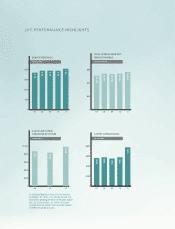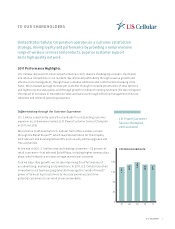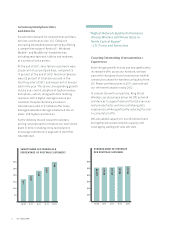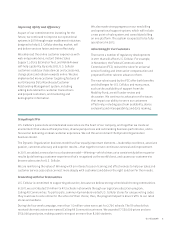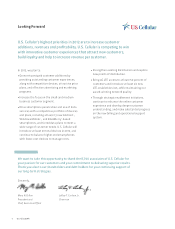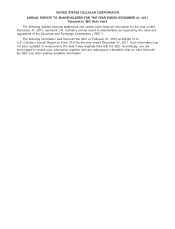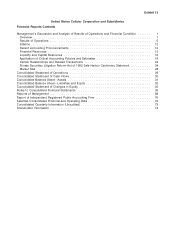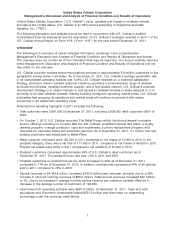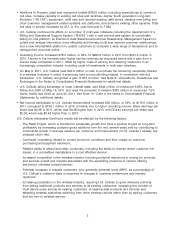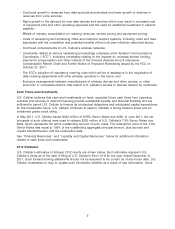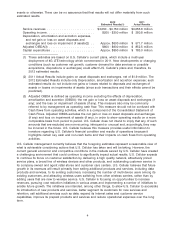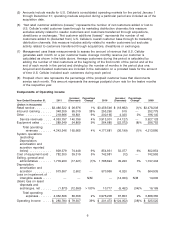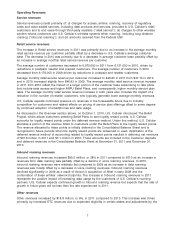US Cellular 2011 Annual Report Download - page 5
Download and view the complete annual report
Please find page 5 of the 2011 US Cellular annual report below. You can navigate through the pages in the report by either clicking on the pages listed below, or by using the keyword search tool below to find specific information within the annual report.
Improving Agility and Efficiency
As part of our commitment to investing for the
future, we continued to improve our operational
systems in 2011 through major enablement initiatives
designed to help U.S. Cellular develop, market, sell
and deliver services faster and more effectively.
We enhanced the online customer experience with
web-only promotions, instant Online Sales
Support, a Data Estimator Tool, and Ask & Answer
self-help capability. By early 2012, U.S. Cellular
customers could purchase devices and accessories,
change plans and redeem rewards online. We also
implemented more customer targeting features of
our Enterprise Data Warehouse/Customer
Relationship Management system, including
adding data related to customer transactions
and prepaid customers, and marketing and
demographic information.
We also made strong progress on our new billing
and operational support system, which will include
a new point-of-sale system and consolidate billing
on one platform. The system is expected to be fully
operational in 2013.
Advocating for Our Customers
There were a number of regulatory developments
in 2011 that will affect U.S. Cellular. For example,
in November, the Federal Communications
Commission (FCC) revised the rules for universal
service funding and intercarrier compensation and
proposed further rules to advance reform.
The new rules issued by the FCC offer both benefits
and challenges for U.S. Cellular, and many areas,
such as the availability of support from the
Mobility Fund, are still under review and
discussion. We continue to advocate on the issues
that impact our ability to serve our customers
effectively, including spectrum availability, device
exclusivity and interoperability, and data roaming.
U.S. CELLULAR 3
Competing to Win
U.S. Cellular’s passionate and dedicated associates are the heart of our company, and together we create an
environment that values ethical practices, diverse perspectives and outstanding business performance, and is
focused on delivering an ideal customer experience. We call this environment the Dynamic Organization
business model.
The Dynamic Organization business model has four equally important elements—leadership excellence, associate
passion, customer advocacy and superior results—that together create continuous renewal and improvement.
In 2011, we added a new value to our business model—Winning—which drives us to consistently deliver superior
results by delivering a customer experience that’s recognized as the world’s best, and causes our customers to
become advocates for U.S. Cellular.
We are reinforcing the value of Winning with an intense focus on training and effectiveness to help our sales and
customer service associates connect more deeply with customers and deliver the right solution for their needs.
Connecting with Our Communities
U.S. Cellular is committed to supporting education, because we believe strong schools build strong communities.
In 2011, we contributed $1 million to K-12 schools nationwide through our signature education program,
Calling All Communities. To participate, community members visited U.S. Cellular stores for unique voting codes
they could use to vote online for the school of their choice; thus, the program helped to drive traffic to our retail
stores and website.
During the four-week campaign, more than 1.5 million votes were cast for 2,700 schools. The 18 schools that
received the most votes were named Calling All Communities winners. We awarded 17 $50,000 prizes and one
$150,000 grand prize, making a positive impact on more than 8,000 students.


